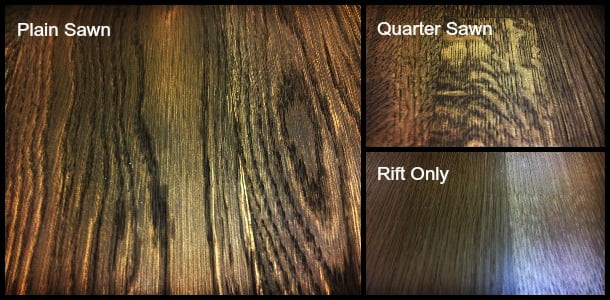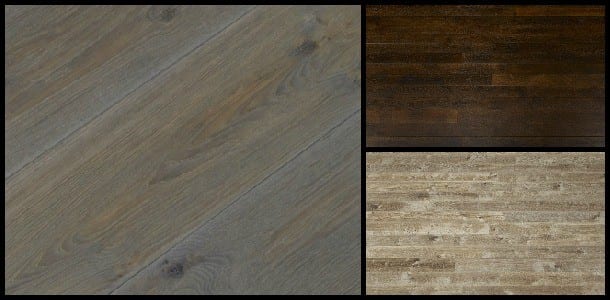The allure and interest surrounding true European Oak, most of which comes from France or Germany, has an interesting explanation. People are intrigued with its uniqueness because it is unlike product that most Americans associate with Oak. In fact, Oak is the staple of the lumber industry, by far the most popular specie and most widely utilized in our culture. Its presence in our daily lives goes unnoticed to most, yet it is everywhere. Designers and Architects who specify wood flooring, veneers, cabinetry or millwork on projects are intimately familiar with Oak. Yet, they are not always familiar with the significant differences that make European Oak such a rich product in design and functionality.
American White Oak
First we examine standard American White Oak. It has 3 traditional cuts. The most common is Plain Sawn, also referred to as Flat Cut, which showcases a traditional Cathedral grain pattern. Next is Quarter Sawn which identifiable by the “flake” appearance in the grain. Finally, we have Rift Cut which illustrates a very straight grain pattern. The industry standard of mixing Rift Cut and Quartered Cut Oak that has been used for centuries. Specifically regarding Rift cut, Woodwright has been sourcing “Rift Only” White Oak for years because our clientele love and request it often. It is more scarce than ever, but with careful planning can be used to create a stunning aesthetic.

European Oak
Now that we have briefly examined traditional American White Oak, let’s take a look at true European Oak. So what really makes European Oak so unique? It’s all in the way it is cut from the log.
The Europeans have a technique that involves taking a “square” from the center of a log, called a cant, and slicing it straight through. It also has a slower growing cycle, which produces a tighter grain. The result is a wider plank, typically 7-10″, with a gorgeous plain sawn look near the center, flanked by a unique rift & quartered grain pattern, all in the same piece of wood. Yes, you read that correctly, all three cuts in one plank!

Some American mills have recognized the popularity of the European Oak and are now supplying us with lumber and flooring that they cut in the same manner as the European method. It is referred to as Eurocut, Center Cut, Live Sawn or even French Cut Oak, and it offers tremendous opportunities for our A&D clients to specify something out of the norm, yet often stay within budget. Woodwright’s newly expanded manufacturing facility at 425 Regal Row in Dallas is engineering “Eurocut” on a regular basis. If you or your client prefers the true beauty of European Oak, we can accommodate those needs as well.
Our A+D Consultants are happy to collaborate with you to create a visually stunning and unique project. We have a full-time sample department that can fulfill requests with a reasonable production time. Please feel free to contact your A+D consultant to begin working with our award-winning, turnkey solution.
Sincerely, Rick Farrell
